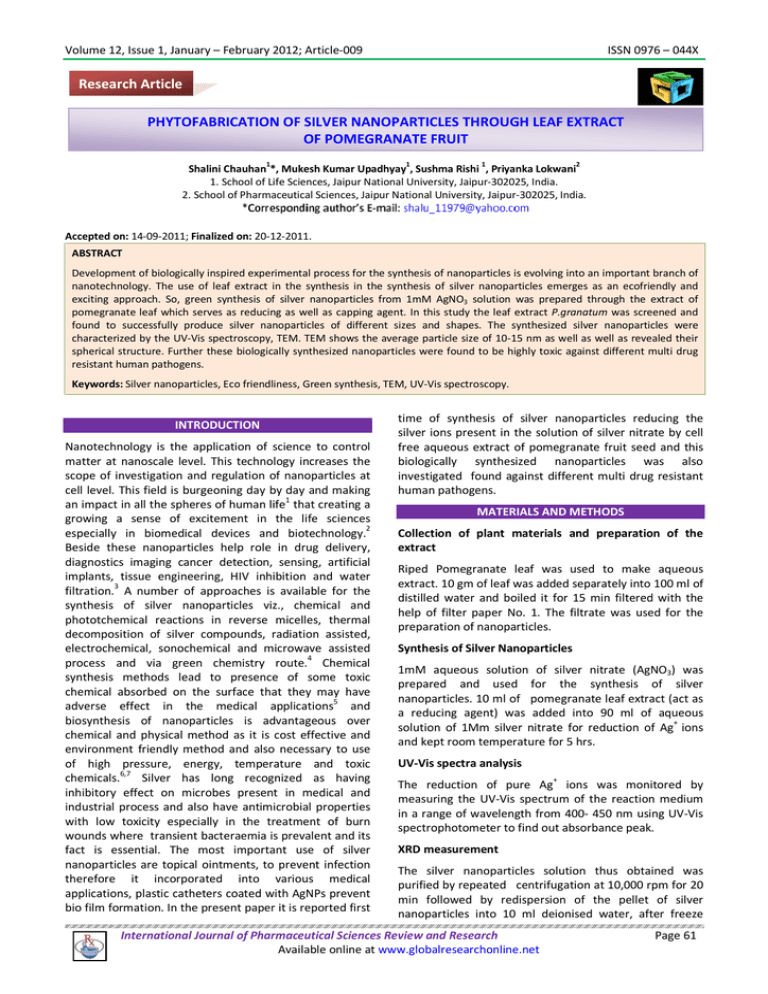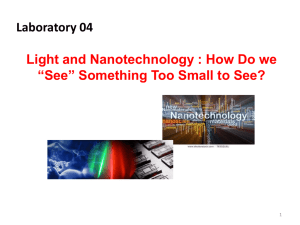Document 13308655
advertisement

Volume 12, Issue 1, January – February 2012; Article-009 ISSN 0976 – 044X Research Article PHYTOFABRICATION OF SILVER NANOPARTICLES THROUGH LEAF EXTRACT OF POMEGRANATE FRUIT 1 1 1 2 Shalini Chauhan *, Mukesh Kumar Upadhyay , Sushma Rishi , Priyanka Lokwani 1. School of Life Sciences, Jaipur National University, Jaipur-302025, India. 2. School of Pharmaceutical Sciences, Jaipur National University, Jaipur-302025, India. Accepted on: 14-09-2011; Finalized on: 20-12-2011. ABSTRACT Development of biologically inspired experimental process for the synthesis of nanoparticles is evolving into an important branch of nanotechnology. The use of leaf extract in the synthesis in the synthesis of silver nanoparticles emerges as an ecofriendly and exciting approach. So, green synthesis of silver nanoparticles from 1mM AgNO3 solution was prepared through the extract of pomegranate leaf which serves as reducing as well as capping agent. In this study the leaf extract P.granatum was screened and found to successfully produce silver nanoparticles of different sizes and shapes. The synthesized silver nanoparticles were characterized by the UV-Vis spectroscopy, TEM. TEM shows the average particle size of 10-15 nm as well as well as revealed their spherical structure. Further these biologically synthesized nanoparticles were found to be highly toxic against different multi drug resistant human pathogens. Keywords: Silver nanoparticles, Eco friendliness, Green synthesis, TEM, UV-Vis spectroscopy. INTRODUCTION Nanotechnology is the application of science to control matter at nanoscale level. This technology increases the scope of investigation and regulation of nanoparticles at cell level. This field is burgeoning day by day and making an impact in all the spheres of human life1 that creating a growing a sense of excitement in the life sciences especially in biomedical devices and biotechnology.2 Beside these nanoparticles help role in drug delivery, diagnostics imaging cancer detection, sensing, artificial implants, tissue engineering, HIV inhibition and water filtration.3 A number of approaches is available for the synthesis of silver nanoparticles viz., chemical and phototchemical reactions in reverse micelles, thermal decomposition of silver compounds, radiation assisted, electrochemical, sonochemical and microwave assisted process and via green chemistry route.4 Chemical synthesis methods lead to presence of some toxic chemical absorbed on the surface that they may have adverse effect in the medical applications5 and biosynthesis of nanoparticles is advantageous over chemical and physical method as it is cost effective and environment friendly method and also necessary to use of high pressure, energy, temperature and toxic 6,7 chemicals. Silver has long recognized as having inhibitory effect on microbes present in medical and industrial process and also have antimicrobial properties with low toxicity especially in the treatment of burn wounds where transient bacteraemia is prevalent and its fact is essential. The most important use of silver nanoparticles are topical ointments, to prevent infection therefore it incorporated into various medical applications, plastic catheters coated with AgNPs prevent bio film formation. In the present paper it is reported first time of synthesis of silver nanoparticles reducing the silver ions present in the solution of silver nitrate by cell free aqueous extract of pomegranate fruit seed and this biologically synthesized nanoparticles was also investigated found against different multi drug resistant human pathogens. MATERIALS AND METHODS Collection of plant materials and preparation of the extract Riped Pomegranate leaf was used to make aqueous extract. 10 gm of leaf was added separately into 100 ml of distilled water and boiled it for 15 min filtered with the help of filter paper No. 1. The filtrate was used for the preparation of nanoparticles. Synthesis of Silver Nanoparticles 1mM aqueous solution of silver nitrate (AgNO3) was prepared and used for the synthesis of silver nanoparticles. 10 ml of pomegranate leaf extract (act as a reducing agent) was added into 90 ml of aqueous solution of 1Mm silver nitrate for reduction of Ag+ ions and kept room temperature for 5 hrs. UV-Vis spectra analysis The reduction of pure Ag+ ions was monitored by measuring the UV-Vis spectrum of the reaction medium in a range of wavelength from 400- 450 nm using UV-Vis spectrophotometer to find out absorbance peak. XRD measurement The silver nanoparticles solution thus obtained was purified by repeated centrifugation at 10,000 rpm for 20 min followed by redispersion of the pellet of silver nanoparticles into 10 ml deionised water, after freeze International Journal of Pharmaceutical Sciences Review and Research Available online at www.globalresearchonline.net Page 61 Volume 12, Issue 1, January – February 2012; Article-009 drying the purified silver nanoparticles were analysed by XRD. XRD help to determine the crystalline domain size. TEM analysis ISSN 0976 – 044X It is generally visualized under the UV-Vis Spectroscopy could be used to examine size and shaped controlled nanoparticles in aqueous suspensions. 0.5 Antibacterial assay 5 hour 0.4 3hour 0.35 1hour 0.3 0.25 0.2 0.15 0.1 0.05 0 0 35 The antibacterial assays were done on human pathogenic Escherichia coli and Pseudomonas aeruginosa by food poisoning and disk diffusion method. DISC DIFFUSION METHOD: Prepared the plate of NA plates. Fresh overnight culture of inoculum 100µl of each culture was spread on LB plates. Sterile paper disc of 5mm diameter containing 5o mg/lit. Silver nanoparticles along with four standard disc were placed in each plate. Antifungal assay The assay was carried out in petri plates containing 10 ml of PDA supplemented with silver nanoparticles. To asses antifungal activity Aspergillus flavus was spot inoculated on PDA plates, which then were incubated at 28ᵒC for 72 hrs. The diameter of mycelial colony developing on the silver nanoparticles containing PDA plates and compared with the diameter of colony obtained on control plates. The inhibition of fungal growth was calculated by following formula: silver 0.45 absorbance TEM analysis of silver nanoparticles synthesized by pomegranate seed extract were prepared by placing drops of the reaction mixture over carbon coated grid and allowing the solvent to evaporate TEM measured were performed by JOEL model 1200 Ex instrument operating at a voltage of 80 K. TEM basically used for the determination of size and shape of the synthesized silver nanoparticles. 0 37 0 39 0 41 0 0 0 w43 avelength 45 47 0 49 Figure 2: UV–Vis spectrophotometer analysis Figure 2 showed that UV–Vis spectra recorded from the reaction medium after 4 hrs. Intense absorption peak observed at 430 nm, broadening of polydispersed. The XRD pattern (figure 3) showed intense peak in the whole spectrum of 2θ value ranging 10 to 80. The TEM images (figure 4) showing the high density silver nanoparticles synthesized by the pomegranate seed extract further confirmed the development of silver nanostructures, So that TEM analysis clearly reveals the shape of silver nanoparticles would be spherical and size is 10-15 nm. % inhibition = (C-E) X 100 / C Where C= the diameter of fungal mycelium on control plate and E= is diameter of fungal mycelium on the experimental plate. RESULTS AND DISSCUSION It is well understood that silver nanoparticles exhibit yellowish brown colour in aqueous solution due to excitation of surface Plasmon vibration in silver nanoparticles. As the pomegranate fruit leaf extract was mixed in the aqueous solution of the silver ion complex, it started to change the colour from watery to yellowish brown due to the reduction of silver ion (Figure 1); which indicated the formation of silver nanoparticles. Figure 3: XRD IMAGE OF LEAF Figure 4: TEM IMAGES Figure 1: Leaf extract after colour change Further the nanoparticles syntheses by green route are found highly toxic against multi drug resistant human pathogens bacteria at a concentration of 50 ppm (Figure 6). Silver nanoparticles exhibited antifungal activity as it showed a clear inhibition zone comparative study with International Journal of Pharmaceutical Sciences Review and Research Available online at www.globalresearchonline.net Page 62 Volume 12, Issue 1, January – February 2012; Article-009 Kanamycin (Figure 5). Antibacterial effects of Ag nanoparticles obeyed a dual action mechanism of antibacterial activity, i.e., the bactericidal effect of Ag and membrane - disturbing effect of the polymer subunits. Reduction of silver ions present in the aqueous solution of silver complex during the reaction with the ingredients present in the pomegranate seed extract observed by the UV-Vis spectroscopy revealed the presence of silver nanoparticles may be correlated with the UV-Vis spectra because UV-Vis is basically used for the determination of size and shape of nanoparticles when increase of silver nanoparticles reactivity would be less. TEM analysed the size of the silver nanoparticles size that is between in 1030 nm as well the spherical in structure. The silver nanoparticles synthesized via green route are highly toxic to the multidrug resistant bacteria hence great potential in biomedical and therapeutic purposes. The present study showed a simple, one step process and economical route to synthesized silver nanoparticles. ISSN 0976 – 044X CONCLUSION In conclusion of this study the bio-reduction of aqueous Ag+ ions by the fruit extract of the pomegranate seed extract plant has been demonstrated. The reduction of the metal ions through pomegranate leaf extract leading to the formation of silver nanoparticles of fairly well defined dimensions. In the present study we found that’s fruits can also good source for synthesis of silver nanoparticles. This green chemistry approach towards the synthesis of silver nanoparticles has many advantages such as ease with which the process can be scaled up, economic viability etc. Applications of such eco-friendly nanoparticles in method potentially exciting for the large – scale synthesis of other inorganic materials (nanomaterials). Though there is a report describing synthesis of silver nanoparticles using pomegranate seed extract, but the present study used fruit as a source which is easily available and economic unlike other procedure which needs extensive facilities and expertise. Toxicity studies of silver nanoparticles on human pathogens open a door for a new range of antimicrobial agents. REFERENCES 1. Mandal D, Bolander ME, Mukhoupadhyay D, Sarkar G, Mukherjee P. The use of microorganism for the preparation of metal nanoparticles and their application. Applied Microbiology and Biotechnology 69: 2006, 485-492. 2. Prabhu N, Divya T Raj, Yamuna Gowri K, Ayisha Siddqua .S. Synthesis of silver phytonanoparticles and their antibacterial efficacy. Digest journal of Nanomaterials and biostrctures 5:2010, 185-189. 3. Morones JR, Elechiguerra JL, Camacho A, Holt K, Kouri JB, Ramfrez JT Yacaman MJ. The bactericidal effect of silver nanoparticles. Nanotechnology 16: 2005, 2346- 2353. 4. Parashar V, Parashar R, Sharma B, Pandey Avinash C. Parthenium leaf extract mediated synthesis of silver nanoparticles: A novel approach towards weed utilisation. Digest journal of Nanomaterials and biostrctures 4:2009, 45-50. 5. Jain D, Daima H K, Kachhwaha S, Kothari SL. Synthesis of silver nanoparticles using fruit papaya fruit extract and evaluation their antimicrobial activities. Digest journal of Nanomaterials and Bio structures 4:2009, 557- 563. 6. Kowshik M, Ashtaputre S, Kharrazi S, Vogel W, Urban J, Kulkarni SK, Panikar KM. Exracellular syntheisi of silver tolrent yeast strain MKY3. Nanotechnology 14: 2003, 95100. 7. Nabikhan A, Kathiersan K, Raj A, Alikunhi M. Nabeel. Synthesis of antimicrobial silver nanoparticles by callus and leaf extracts from saltmarsh plants, Sesuvium portulacastrum L.Colliods and surface: Biointerfaces79:2009, 488-493. Figure 5: Antifungal activity Figure 6: Antibacterial activity Antifungal result shown at Aspergillus flavus: % inhibition = (C-E) X 100 / C Where C= Diameter of fungal mycelium on control plate. E= Diameter of fungal mycelium on the experimental plate. (% inhibition of Aspergillus flavus found is 50 %) Figure 6 Images of antibacterial activities of discs 30 mg /l of silver nanoparticles and other antibiotics (Kanamycin). It was reported that the inhibition rate of 3µl of leaf extract nanoparticles against E.coli is .0012 mm. ******************* International Journal of Pharmaceutical Sciences Review and Research Available online at www.globalresearchonline.net Page 63






